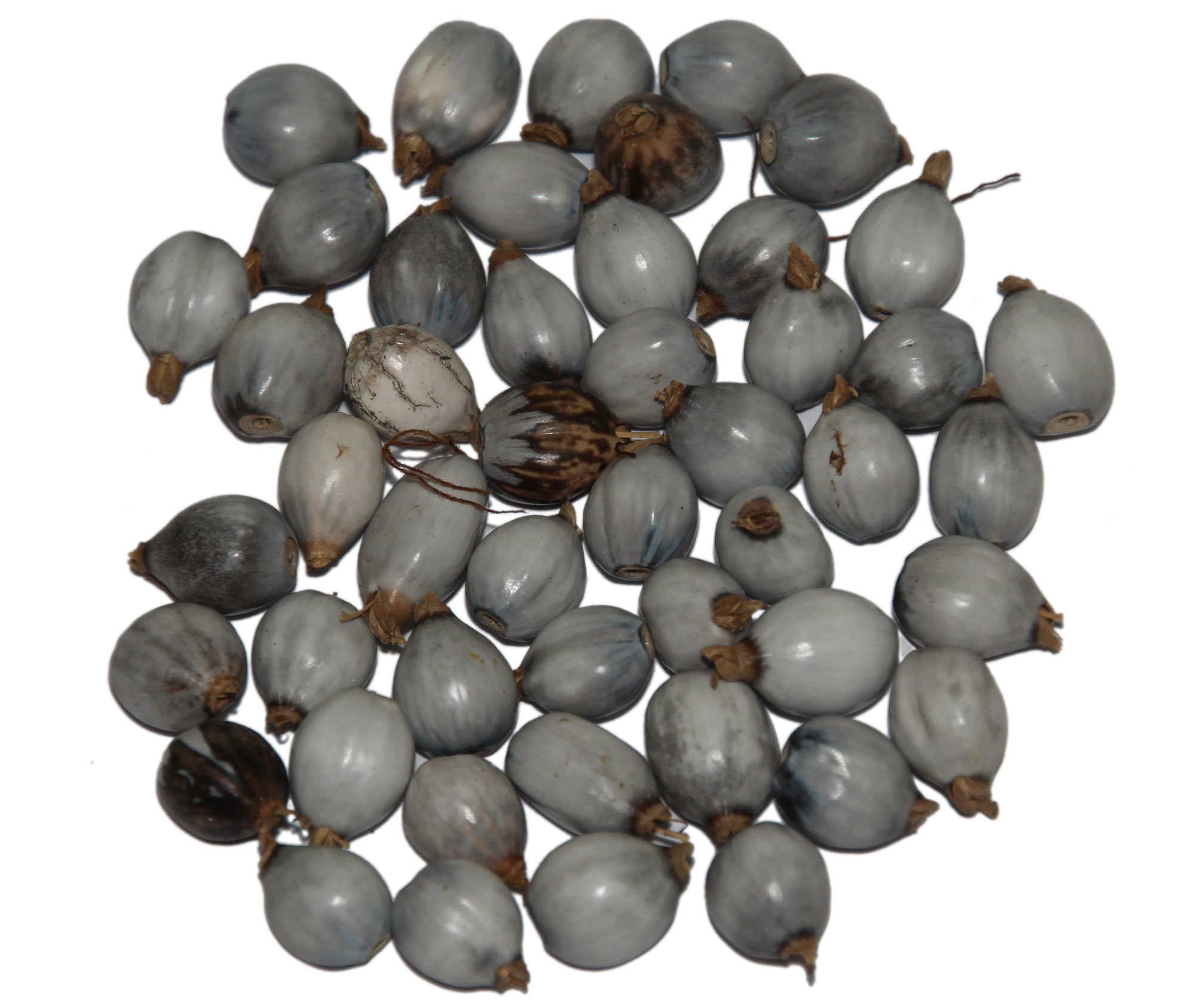Page snapshot: Quick facts about adlay (Coix lacryma-jobi), a grass grown for grain and for decorative purposes.
Topics covered on this page: What is adlay?; Where did adlay come from?; How is adlay used?; How is adlay grown?; Where is adlay grown?; Resources.
Credits: Funded by the National Science Foundation. Any opinions, findings, and conclusions or recommendations expressed in this material are those of the author(s) and do not necessarily reflect the views of the National Science Foundation. Page by Elizabeth J. Hermsen (2023).
Updates: Page last updated March 6, 2023.
Image above: Adlay grains. Photo by Walter Grassroot (Wikimedia Commons, Creative Commons Attribution-ShareAlike 4.0 International license, image cropped).
What is adlay?
Adlay (also called adlay millet, Chinese pearl barley, coix, and Job's tears, among other common names) is a tropical grass (Coix lacryma-jobi). Two varieties are cultivated, one (C. lacryma-jobi var. ma-yuen) primarily for grain, the other (C. lacryma-jobi var. lacryma-jobi) primarily for the hard, bead-like utricles (cases formed by modified leaves) surrounding the fruits.

Adlay (Coix lacryma-jobi), cultivated, Poland. Photo by Salicyna (Wikimedia Commons, Creative Commons Attribution-ShareAlike 4.0 International license, image cropped and resized).

Adlay (Coix lacryma-jobi), Kopiliula, Maui. Photo by Forest and Kim Starr (Image no. 5390696, Invasive.org, Creative Commons Attribution 3.0 United States license).
Where did adlay come from?
Adlay is native to southern Asia to southeast Asia, from India to eastern China and south to the island of Borneo. Adlay has been widely introduced elsewhere.
Adlay was probably domesticated thousands of years ago, although the exact time and place of its domestication in Asia are unclear. Evidence of human use of wild adlay dates to at least 18,000 to 28,000 years ago in China, whereas evidence from archaeological sites indicates that adlay has been cultivated in China for around 8,000 years.
How is adlay used?
The variety of adlay with a soft utricle, Coix lacryma-jobi var. ma-yuen, is cultivated for its grain. The grain may be eaten cooked, or it may be ground to make flour. Sometimes, the grain is used to make tea or fermented to make beer or wine.
The variety of adlay with a hard utricle, Coix lacryma-jobi var. lacryma-jobi, is cultivated for use as beads. The beads are traditionally used for rosaries or prayer beads, as well as in other jewelry and to decorate textiles. Some wild kinds of adlay (like Coix lacryma-jobi var. stenocarpa) are also used as beads.
Adlay is also used as a feed and fodder plant for livestock.

Bags of adlay grains (left) and fried grains (right), here labeled "coix seed," for sale in Hong Kong, 2021. Photo by Zhiufook Hung Kwanling (Wikimedia Commons, Creative Commons Attribution-ShareAlike 4.0 International license, image resized).

Adlay seeds with utricles. Photo by Lionel Allorge (Wikimedia Commons, Creative Commons Attribution-ShareAlike 3.0 Unported license, image cropped and resized).

A belt decorated with adlay beads made by a member of the Hmong ethic group in Laos. Photo by Bibamwen (Wikimedia Commons, Creative Commons Attribution-ShareAlike 4.0 International license, image resized).

A textile decorated with beads made of adlay (possibly Coix lacryma-jobi var. stenocarpa) from Vietnam. Photo by Daderot (Wikimedia Commons, CC0 1.0 Universal, public domain dedication).
How is adlay grown?
Like other grass grain crops, adlay is grown in cultivated fields. Adlay is grown from seed and cultivated as an annual. In suitable climates, it can be cultivated as a perennial. The crop is harvested by cutting the grass above the base. If grown as a perennial, the crop is allowed to regrow several times so that more than one crop can be harvested from a single planting of seeds.
Where is adlay grown?
Adlay is cultivated in places with suitable climates worldwide, primarily in the subtropics and tropics. It can be grown as an annual in more temperate climates if the growing season is long enough.
Resources
Scientific articles
Araro, R. K. 1977. Job's-tears (Coix lacryma-jobi)--a minor food and fodder crop of northeastern India. Economic Botany 31: 358-366.
Liu, L., N. A. Duncan, X. Chen, and J. Cui. 2019. Exploitation of job's tears in Paleolithic and Neolithic China: Methodological problems and solution. Quaternary International 529: 25-37. https://doi.org/10.1016/j.quaint.2018.11.019
Patel, B., G. Patel, S. Shah, S. Parmar. 2017. A review: Coix lacryma jobi L. Research Journal of Pharmacognosy and Phytochemistry 9: 248-252.



